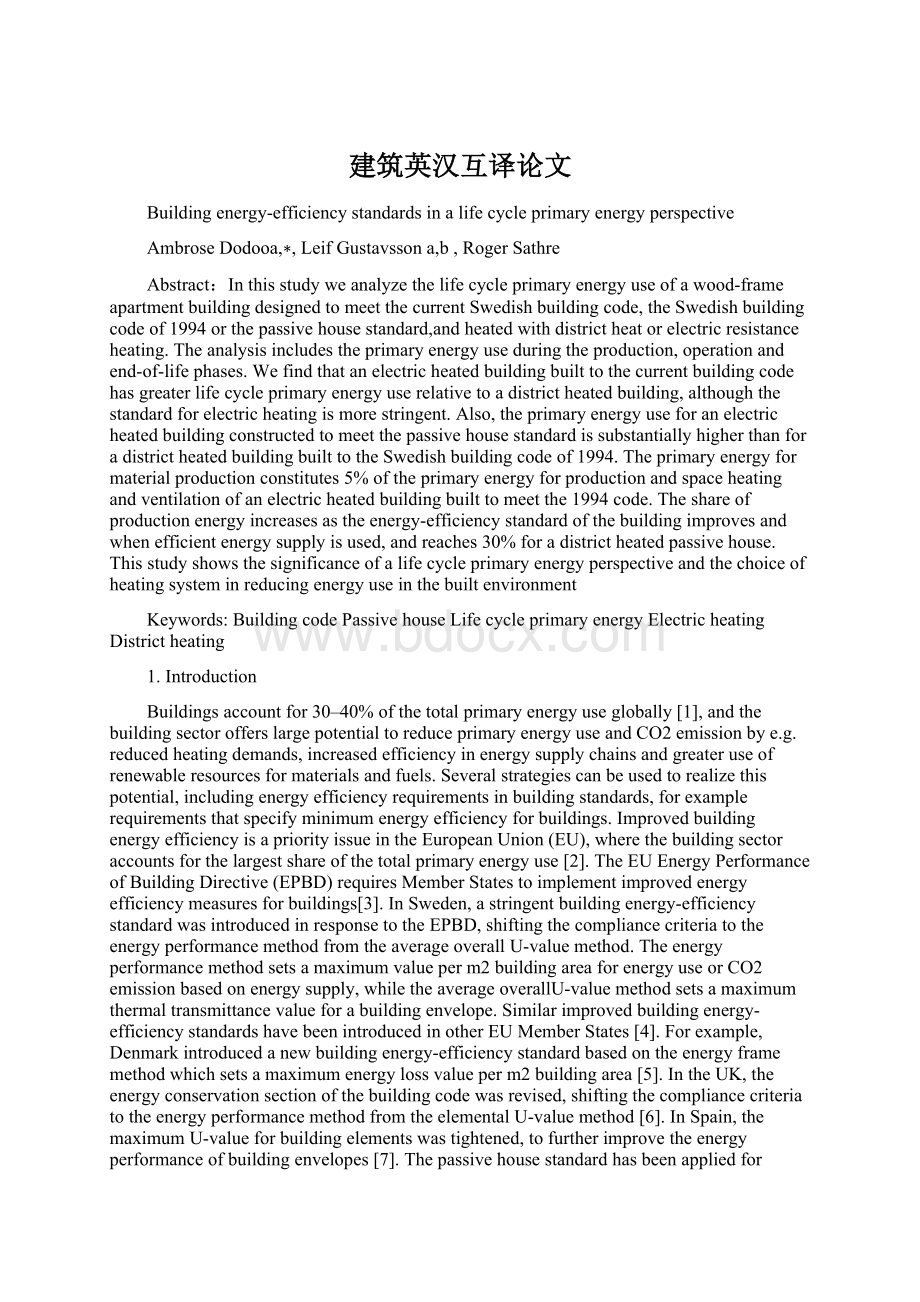建筑英汉互译论文.docx
《建筑英汉互译论文.docx》由会员分享,可在线阅读,更多相关《建筑英汉互译论文.docx(20页珍藏版)》请在冰豆网上搜索。

建筑英汉互译论文
Buildingenergy-efficiencystandardsinalifecycleprimaryenergyperspective
AmbroseDodooa,∗,LeifGustavssona,b,RogerSathre
Abstract:
Inthisstudyweanalyzethelifecycleprimaryenergyuseofawood-frameapartmentbuildingdesignedtomeetthecurrentSwedishbuildingcode,theSwedishbuildingcodeof1994orthepassivehousestandard,andheatedwithdistrictheatorelectricresistanceheating.Theanalysisincludestheprimaryenergyuseduringtheproduction,operationandend-of-lifephases.Wefindthatanelectricheatedbuildingbuilttothecurrentbuildingcodehasgreaterlifecycleprimaryenergyuserelativetoadistrictheatedbuilding,althoughthestandardforelectricheatingismorestringent.Also,theprimaryenergyuseforanelectricheatedbuildingconstructedtomeetthepassivehousestandardissubstantiallyhigherthanforadistrictheatedbuildingbuilttotheSwedishbuildingcodeof1994.Theprimaryenergyformaterialproductionconstitutes5%oftheprimaryenergyforproductionandspaceheatingandventilationofanelectricheatedbuildingbuilttomeetthe1994code.Theshareofproductionenergyincreasesastheenergy-efficiencystandardofthebuildingimprovesandwhenefficientenergysupplyisused,andreaches30%foradistrictheatedpassivehouse.Thisstudyshowsthesignificanceofalifecycleprimaryenergyperspectiveandthechoiceofheatingsysteminreducingenergyuseinthebuiltenvironment
Keywords:
BuildingcodePassivehouseLifecycleprimaryenergyElectricheatingDistrictheating
1.Introduction
Buildingsaccountfor30–40%ofthetotalprimaryenergyuseglobally[1],andthebuildingsectorofferslargepotentialtoreduceprimaryenergyuseandCO2emissionbye.g.reducedheatingdemands,increasedefficiencyinenergysupplychainsandgreateruseofrenewableresourcesformaterialsandfuels.Severalstrategiescanbeusedtorealizethispotential,includingenergyefficiencyrequirementsinbuildingstandards,forexamplerequirementsthatspecifyminimumenergyefficiencyforbuildings.ImprovedbuildingenergyefficiencyisapriorityissueintheEuropeanUnion(EU),wherethebuildingsectoraccountsforthelargestshareofthetotalprimaryenergyuse[2].TheEUEnergyPerformanceofBuildingDirective(EPBD)requiresMemberStatestoimplementimprovedenergyefficiencymeasuresforbuildings[3].InSweden,astringentbuildingenergy-efficiencystandardwasintroducedinresponsetotheEPBD,shiftingthecompliancecriteriatotheenergyperformancemethodfromtheaverageoverallU-valuemethod.Theenergyperformancemethodsetsamaximumvalueperm2buildingareaforenergyuseorCO2emissionbasedonenergysupply,whiletheaverageoverallU-valuemethodsetsamaximumthermaltransmittancevalueforabuildingenvelope.Similarimprovedbuildingenergy-efficiencystandardshavebeenintroducedinotherEUMemberStates[4].Forexample,Denmarkintroducedanewbuildingenergy-efficiencystandardbasedontheenergyframemethodwhichsetsamaximumenergylossvalueperm2buildingarea[5].IntheUK,theenergyconservationsectionofthebuildingcodewasrevised,shiftingthecompliancecriteriatotheenergyperformancemethodfromtheelementalU-valuemethod[6].InSpain,themaximumU-valueforbuildingelementswastightened,tofurtherimprovetheenergyperformanceofbuildingenvelopes[7].ThepassivehousestandardhasbeenappliedforseveralbuildingsinEurope[8],andisgainingincreasingattentionasinterestinbuildingswithlowspaceheatusegrows.
Thespecificapproachofbuildingenergy-efficiencystandardsindealingwithenergyefficiencymayvarybetweencountries.However,buildingenergy-efficiencystandardsgenerallyfocusonfinalenergyuseforoperationbyspecifyingthermalpropertiesandspecificfinalenergyuseforbuildings.Theoperationenergygenerallydominatesthelifecycleenergyuse[9,10],soconstructingbuildingstomeetahighthermalstandardgenerallyreduceslifecycleprimaryenergyuse.However,focusingonlyonoptimizingtheenergyperformanceintheoperationphasemayresultinpotentialtrade-offsinotherlifecyclephases.Forexample,Feist[11]comparedtwobuildingsandfoundthatthebuildingwithloweroperationenergyhadgreatertotallifecycleprimaryenergyusebecauseofitshighproductionenergy.Thusmeasuresthatreduceoperationenergyusedonotnecessarilyreducetotallifecycleprimaryenergyuse.Theprimaryenergyforbuildingproductionbecomesrelativelymoreimportantasmeasuresareappliedtoreducetheoperationenergyuse[12].Thormark[13]foundtheproductionenergytorepresent45%oftotallifecycleprimaryenergyuseinalowenergybuilding.Theenergyimplicationsofbuildingsextendbeyondtheoccupationstage,andinalifecycleperspectiveincludestheproduction,operationandend-of-lifestages.
Theend-useenergyservicesofabuildingcanbeprovidedbyvarioustypesofsupplysystems,whichcanresultinsignificantlydifferentprimaryenergyuse.Forexample,GustavssonandJoelsson[14]foundthatadistrictheatedconventionalhousehaslowerprimaryenergyusethananelectricallyheatedpassivehouse,eventhoughthepassivehousehadsubstantiallylowerfinalenergyuse.Alltheprocessesalongtheenergychain,fromtheextractionofmaterialtorefining,transport,conversiontoheatandelectricityanddistributiontotheusercanbeperformedwithdifferentenergyefficiencyandwithvaryingemissions.Alltheenergyinputfortheseprocessesneedtobeincludedforafulldescriptionofaparticularenergysystem.Acomprehensiveassessmentoftheenergeticimpactofabuildingrequiresasystem-wideperspective,includingalllifecyclephasesofthebuildingandtheentireenergychainfromnaturalresourcestofinalenergyservices.Suchanapproachwouldhelpustounderstandthelifecycleimplicationsofbuildingenergy-efficiencystandardsandtoreducetheprimaryenergyuseinthebuiltenvironment.
Somestudieshaveanalyzedanddiscussedtheenergyimpactofbuildingenergy-efficiencystandardsbutmostofthese[e.g.5–7,15,16]focusontheenergyuseduringtheoperationstageofbuildings.Feist[11]analyzedtheprimaryenergyuseofbuildingsbuilttotheGermanybuildingcodeof1984andthepassivehousestandard,includingtheenergyuseduringtheproductionandoperationstages.Casals[17]analyzedtheprimaryenergyuseofabuildingconstructedtothenewbuildingcodeofSpainandshowedtheimportanceofincludingtheproductionenergyinbuildingenergyassessment.However,studiesthathaveanalyzedtheimplicationsofbuildingenergy-efficiencystandardsfromalifecycleprimaryenergyperspectivearelacking.InthisstudyweanalyzetheimpactoftheSwedishbuildingcodesorpassivehousestandardonthelifecycleprimaryenergyuseofresidentialbuildings.
2.Studydescriptions
2.1.Energyefficiencystandards
Weanalyzecaseswherebuildingsaredesignedtomeettheenergy-efficiencystandardofthecurrentSwedishbuildingcode(BBR2009),theSwedishbuildingcodeof1994(BBR1994)ortheSwedishpassivehouse(Passivhus)standard.TheBBR2009[18]becamemandatoryinJanuary2010andspecifieslimitsforthespecificenergyuseforbuildings,encompassingthefinalenergyuseforspaceheating,domestichotwaterandelectricityforfansandpumpsbutexcludingelectricityforhouseholdappliancesandlighting.Thespecificenergyusestandardforbuildingsvarieswithclimaticzones,andwhetherelectricresistanceornon-electricheatingisused.Themaximumspecificenergyuseforelectricallyheatedbuildingsare95,75and55kWh/m2yearfortheclimatezonesI,IIandIII,respectively(seeFig.1).Fornonelectricresistanceheatedbuildings,thecorrespondingvaluesare150,130and110kWh/m2year,respectively.Also,theaverageU-valueforthewholebuildingenvelopemustnotexceed0.40and0.50W/m2forelectricresistanceandnon-electricheatedbuildings,respectively.
2.2.Buildings
Ourcase-studybuildingisa4-storeymulti-familywood-framebuildingwith16apartmentsandatotalheatedfloorareaof1190m2inVäxjö,insouthernSweden(climatezoneIII).Thebuildingwasbuiltduringthemid-1990stothestandardoftheBBR1994.Theouterwallsofthebuildingconsistofthreelayers,including5cmplaster-compatiblemineralwoolpanels,12cmthicktimberstudswithmineralwoolbetweenthestuds,andawiringandplumbinginstallationlayerconsisting7cmthicktimberstudsandmineralwool.Two-thirdsoftheouterfac¸adeisplasteredwithstucco,withtheremaindercoveredwithwoodpaneling.Thegroundfloorconsistsof1.5cmoakboardingon16cmconcreteslablaidon7cmexpandedpolystyreneand15cmmacadam,andtheremainingfloorsaremadeoflighttimberjoists.Newbuildingsofthesamesizearethenmodeledtoachievetheenergy-efficiencoftheBBR2009forelectricordistrictheatedbuildingsandthePassivhusstandard.Table1showsthethermalenvelopecharacteristicsofthebuildings.TheBBR2009districtheatedbuildinghassimilarthermalenvelopecharacteristicsastheoriginalbuildingbutincludesadditionalmineralwoolinsulationof5and10cmfortheroofatticandexternalwalls,respectively.FortheBBR2009electricheatedbuilding,efficienttapsareassumedtobeusedandtheoverallU-valueofthebuildingenvelopeisassumedtobeimprovedbytriple-glazedwindowswithlowemissivitycoatingandkryptongasfilling;20cmadditionalmineralwoolinsulationintheexternalwall;8cmadditionalmineralwoolinsulationintheroofattic;andmechanicalventilationsystemwith85%heatrecoveryefficiency.ThePassivhusbuildingissimilartotheBBR2009e